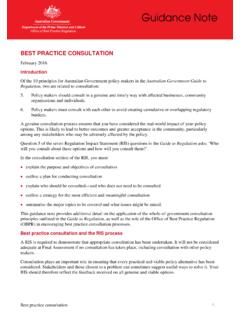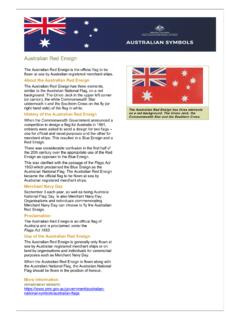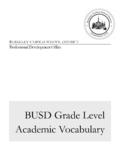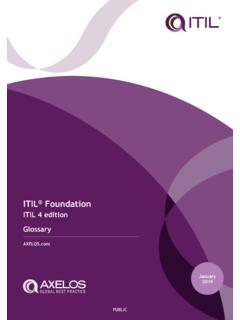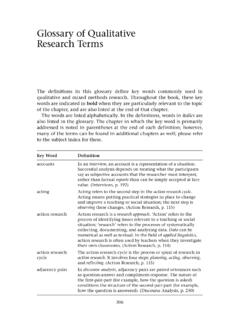Transcription of Best Practice Guide to Applying Data Sharing Principles
1 1 Best Practice Guide to Applying Data Sharing Principles Version: 15 March 2019 2 Contents glossary of terms .. 4 Introduction .. 5 Context .. 5 About this Guide .. 5 The Data Sharing Principles .. 6 Part 1 Before Applying the Data Sharing Principles .. 8 The data Sharing request .. 8 Is the data available and suitable? .. 8 Can the data be shared legally? .. 8 Is there any particular sensitivity in the data? .. 9 Data Sharing Agreements .. 9 Consider how to best meet the user s needs .. 9 Capability and culture.
2 10 Ensuring clear responsibility for each shared dataset .. 10 Governance and the Data Sharing Agreement .. 10 Costs .. 10 Part 2: Applying the Data Sharing Principles .. 12 Managing data Sharing risks .. 12 Diagram 1: data from a single data source can be shared in many different ways .. 12 1. Project Principle: Data is shared for an appropriate purpose that delivers a public benefit .. 13 Data Sharing purpose test .. 13 Assessment of data Sharing projects .. 13 An iterative process .. 14 Diagram 2: the level of project control will depend on the level of detail being shared.
3 15 2. People Principle: The user has the appropriate authority to access the data .. 16 Authorising users .. 16 Training of users .. 16 Diagram 3: the level of user authorisation and training will depend on the level of detail being shared .. 19 3. Settings Principle: The environment in which the data is shared minimises the risk of unauthorised use or disclosure .. 20 Physical environment .. 20 IT environment .. 20 3 Diagram 4: the level of controls applied to the data environment will depend on the level of detail being 22 4.
4 Data Principle: Appropriate and proportionate protections are applied to the data .. 23 Limitations of the Data 23 Treating the data .. 23 Diagram 5: the level of de-identification of data will depend on the level of detail being shared .. 25 5. Output Principle: The output from the data Sharing arrangement is appropriately safeguarded before any further Sharing or release .. 26 Rules-based output checking .. 26 Principles -based output checking .. 26 Diagram 6: the degree to which outputs will need protection will depend on the level of detail being shared.
5 28 Part 3: After Applying the Data Sharing Principles .. 29 Efficient processes .. 29 Diagram 7: Different controls applied to different datasets based on a primary data source .. 30 Further guidance .. 31 Appendices .. 32 Appendix A: Questions to ask under each Principle .. 32 Appendix B: Applying the Data Sharing Principles .. 34 4 glossary of terms Data Custodian: The agency that collects or generates data for any purpose, and is accountable and responsible for the governance of that data. Data Protections: Changes made to data to minimise the likelihood of identifying the Data Provider.
6 Data Provider: An individual, household, business or other entity that supplies data, or has data about them supplied by a third party, to a government agency. Data Release: Making data publicly available with no or few restrictions on who may access the data and what they may do with it. Data Sharing : Making data available to another agency, organisation or person under agreed conditions. Data Sharing Agreement: A formal arrangement between a data custodian and another agency, organisation or individual that details conditions under which data is shared and used.
7 Disclosure Risk: The combination of likelihood and consequence that information about an individual, organisation or other entity is revealed or provided to an unauthorised person or entity. Direct Identifier: Information which, by itself, is able to identify an individual, organisation or other entity. Examples of direct identifiers are name, latitude/longitude, driver s licence number and Australian Business Number. Particularly Sensitive Data: Any data where unauthorised disclosure would likely lead to adverse consequences for the individual, agency, organisation or Australia in general.
8 Data which is of a personal, legal, commercial, security or environmental nature may be considered particularly sensitive. This is broader than the Privacy Act 1988 definition of sensitive data which is defined as a subset of personal information and limits how it can be collected and used. Personal Information: Information or an opinion about an identified individual, or an individual who is reasonably identifiable: (a) whether the information or opinion is true or not true; and (b) whether the information or opinion is recorded in a material form or Responsible Officer: A senior person in an organisation who has the legal authority to agree to conditions of shared data use on behalf of that organisation.
9 1 Privacy Act 1988 5 Introduction Context The Australian Government holds vast amounts of public sector data that it collects from individuals and businesses, or generates through administrative functions of government agencies. This data has significant potential to inform policy development, evaluate programs, contribute to economic growth, and support innovation, for the benefit of all Australians. Acknowledging the value of public sector data, and the need use it efficiently and with appropriate safeguards, the Australian Government established the Office of the National Data Commissioner (ONDC) in July 2018.
10 The ONDC is responsible for implementing a data Sharing framework that improves access to and re-use of public sector data, while maintaining data privacy and security. In this context, data Sharing is the provision of access to data in a controlled manner. Data release means providing open access to data, making it publicly available for anyone to use. The potential of public sector data can be realised in a number of ways. Data Sharing allows re-use of existing data to deliver public benefit and the creation of new datasets to provide rich insights about communities, families, industry, the environment and the economy.




